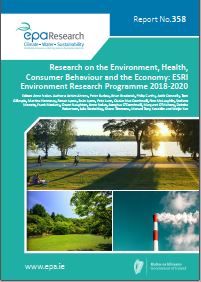Research 358: Research on the Environment, Health, Consumer Behaviour and the Economy: ESRI Environment Research Programme 2018–2020
Authors: Achim Ahrens, Peter Barlow, Brian Broderick, Philip Carthy, Aoife Donnelly, Tom Gillespie, Martina Hennessy, Ronan Lyons, Seán Lyons, Pete Lunn, Ciarán Mac Domhnaill, Finn McLaughlin, Stefano Meneto, Frank Moriarty, Owen Naughton, Anne Nolan, Aonghus O´Domhnaill, Margaret O’Mahony, Deirdre Robertson, Iulia Siedschlag, Shane Timmons, Manuel Tong Koecklin and Weijie Yan. Editor: Anne Nolan
Summary: The EPA/ESRI Environment Research Programme brings together a diverse set of research topics with the objective of assessing the ways in which the environment interacts with economic and social processes. This report provides a detailed summary of the 12 topics examined in the second phase of the programme, which was carried out between 2018 and 2020.

Project Highlights
Watch the project highlights video
Identifying Pressures
The Environmental Protection Agency/Economic and Social Research Institute Environment Research Programme brings together a diverse set of research topics with the objective of assessing the ways in which the environment interacts with economic and social processes. This report provides a detailed summary of the 12 topics examined in the second phase of the programme, which was carried out between 2018 and 2020. These topics can be grouped into five broad themes:
- examining the impact of the environment on health and wellbeing;
- characteristics of biodiversity data recorders;
- using behavioural science to design and test behaviourally informed regulatory communications;
- examining the drivers and consequences of green innovations and green investments;
- investigating land use and spatial planning issues.
Informing Policy
The research identified strong links between environmental conditions and health and wellbeing. In particular, living in areas with higher levels of NO2 pollution was associated with higher rates of asthma in people aged 50 and over. It is notable that an effect was found even though standard regulatory limits are rarely exceeded in Ireland.
Evidence of an association between high housing costs and longer commuting distances was identified. This implies potentially difficult policy trade-offs; for example, local preferences for restrictions on development in cities could affect the supply of housing in cities. However, the linkage between urban rents and commuting distances may be weakened if there is a sustained shift towards remote working in the future.
The research showed that environmental quality and firm performance go together. Policy-induced green innovations are beneficial for firms’ international competitiveness. In the medium term, firms’ investments in environmental protection increase their performance. However, not all firms benefit equally from green investments. Taken together, these results suggest that targeted policy measures to enable small and medium-sized firms in particular to invest in environmental protection could be beneficial.
Developing Solutions
Findings from the studies that examined the social and economic aspects of urban green space suggest that the design of urban green spaces should consider not only the quantity and accessibility of urban green space but also the wider characteristics of the area, such as cleanliness and safety, that encourage the use of urban green space.
A study of newly recruited biodiversity data recorders, carried out in partnership with the National Biodiversity Data Centre, showed that the biodiversity data recorders were more socioeconomically advantaged, more engaged in environmental protection and more physically active than the general population. These insights can help in recruitment campaigns and in designing research activities that involve citizen scientists.
The results from the behavioural science strand established that the importance assigned to different environmental regulations can be altered by the language used to present them. Framing regulations as preventing environmental damage was the most effective strategy, particularly among individuals who are less likely to consider environmental harms. These results imply that the communication strategies should highlight the function of regulations rather than appeal to other rationales (such as protecting Irish values).
https://www.epa.ie/media/epa-2020/publications/research/Thumbnail_358.jpg